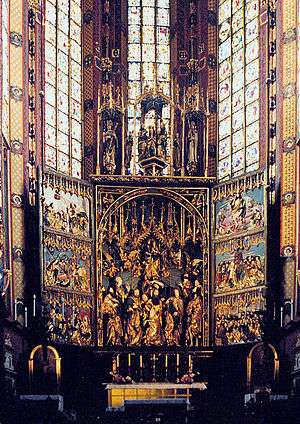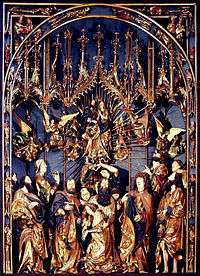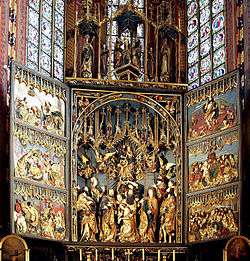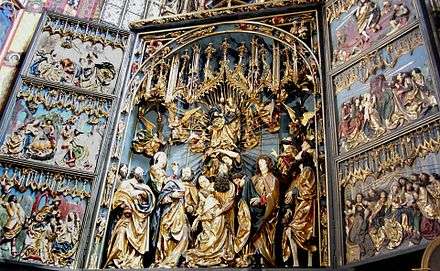Veit Stoss altarpiece in Kraków
The Altarpiece by Veit Stoss in Kraków (Polish: Ołtarz Wita Stwosza, German: Krakauer Hochaltar), also St. Mary's Altar (Ołtarz Mariacki), is the largest Gothic altarpiece in the world and a national treasure of Poland.[1] It is located behind the High altar of St. Mary's Basilica in Kraków. The altarpiece was carved between 1477 and 1489 by the German sculptor Veit Stoss (known in Polish as Wit Stwosz) who lived and worked in the city for over 20 years.

In 1941, during the German occupation, the dismantled altarpiece was shipped to the Third Reich on the order of Hans Frank – the Governor-General of that part of occupied Poland. It was recovered in 1946 in Bavaria, hidden in the basement of the heavily bombed Nuremberg Castle. The High Altar underwent major restoration work in Poland and was put back in its place at the Basilica 10 years later.[2]
History

World War II
A few weeks prior to the outbreak of the Second World War and the German occupation of Poland, the Poles took the altarpiece apart and stored its main statues in crates dispersed across the country.[1] The crates were located by a Nazi unit called the Sonderkommando Paulsen, plundered and transported to the Third Reich, likely to Berlin. The panels were also found and sent to Germany. They were put in the basement of the Nuremberg Castle.[1] At the castle, Polish prisoners sent messages to members of the Polish resistance that the revered altarpiece was hidden there.[1] The altarpiece survived the war in spite of heavy bombardment of Nuremberg, and was discovered by Count Emeryk Hutten-Czapski, who was attached to the Polish 1st Armoured Division, and it was returned to Poland in 1946,[2] where it underwent major restoration. It was put back at St. Mary's Basilica in 1957.[Note 1][1]
The altarpiece was restored several times in its history, not only after the end of World War II. For the first time, it was renovated before 1600, then in 1866–1870, 1932–1933, 1946–1949, 1999 and finally, in 2017.
St. John Cantius in Chicago, a historic church in the 'Polish Cathedral' style contains a detailed copy of this masterpiece. This one-third scale copy is the largest and most detailed work of its kind, and was commissioned in 2003 as a tribute to the immigrants from the Galicia region of Poland and Ukraine who founded the parish in 1893.
Description
The Veit Stoss Altarpiece is about 13 m high and 11 m wide when the panels of the triptych are completely opened. The realistically sculptured figures are 2.7 m (more than 12 ft.) high;[1] each one was carved out of a tree trunk of lime (linden). Other parts of the altarpiece are made from oak wood, and the background is constructed of larch wood. When closed, the panels show 12 scenes of the life of Jesus and Mary.
The scene at the bottom of the main altarpiece (centre) shows the death of Jesus' mother, Mary, in the presence of the Twelve Apostles. The upper centre part illustrates the Assumption of the Madonna. At the very top, outside the main frame, the coronation of Mary is shown, flanked by figures of Saint Stanislaus and Saint Adalbert of Prague. The side panels show the six scenes of the Joys of Mary:
Annunciation |
 Centre scene, the death of Mary Mother of Jesus, in the presence of the Twelve Apostles |
Resurrection of Christ | ||
Nativity scene |
Ascension of Christ | |||
Three Wise Men |
Descent of the Holy Spirit | |||
Photographs
 Overview
Overview Centre of the altarpiece
Centre of the altarpiece- Dormition of Mary
- Dormition of Mary, detail
- Assumption of Mary
- Coronation of Mary, with St. Stanislaus and St. Adalbert
- Annunciation
- Nativity scene
- Three Wise Men
- Resurrection of Christ
- Ascension of Christ
- Descent of the Holy Spirit
Notes
- Veit Stoss born a Nuremberger, met the Nazis' definition of "Aryan", and the German administration considered his altarpiece to be German property.
References
- Kurtz, Michael J. (2006). America and the return of Nazi contraband. Cambridge University Press. p. 25.
- Życie i twórczość Wita Stwosza (Life and Art of Wit Stwosz.) Jagiellonian University (in Polish)
| Wikimedia Commons has media related to Altar of Veit Stoss. |
- Burkhard, Arthur. The Cracow Altar of Veit Stoss. Munich, F. Bruckmann, 1972.
- Bujak, Adam - Rożek, Michał (text). Cracow - St. Mary's Basilica. Biały Kruk, 2001, ISBN 83-914021-8-5
- Encyklopedia Krakowa, Wydawnictwo Naukowe PWN, Warszawa-Kraków 2000, ISBN 83-01-13325-2